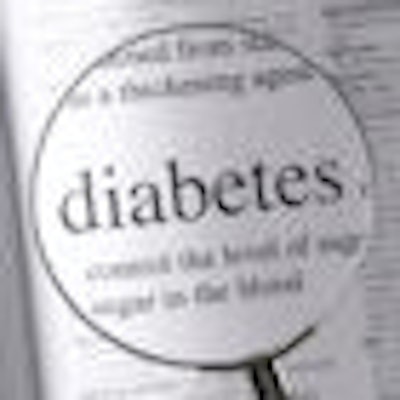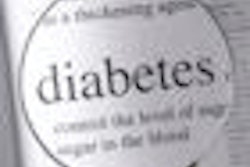
Dentists and patients agree that blood sugar testing in dental offices is useful and should be done routinely, according to a new study in the Journal of the American Dental Association.
Type 2 diabetes mellitus (DM) has been increasing at epidemic rates, the study authors noted. More than 12% of the U.S. population suffers from DM, making it one of the most common and costly chronic conditions in the country. In addition, prediabetes affects about 54 million Americans, meaning a quarter of the U.S. population has impaired glucose metabolism.
Detecting these conditions and treating them adequately are major public health objectives, according to lead researcher Andrei Barasch, DMD, formerly associate professor at the University of Alabama at Birmingham School of Dentistry and now chairman of the Department of Dental Medicine at Winthrop University Hospital.
The dental office is uniquely suited for screening patients for specific conditions, and study results have demonstrated that it can be used for preventive health interventions, such as smoking cessation, the study authors noted. However, most dental practitioners regard blood glucose testing as outside their scope of practice, and only a few dental offices own and use a glucometer, the researchers wrote.
Multicenter international study
The JADA study (March 2012, Vol. 143:3, pp. 262-269) was conducted through the Dental Practice-Based Research Network using responses from dentists and staff members in community practices in Sweden and five U.S. regions: Alabama/Mississippi, Florida/Georgia, Minnesota, and Permanente Dental Associates in Oregon and Washington state.
The goal was to test the feasibility of screening patients for abnormal random blood glucose levels using glucometers and finger-stick testing. Practitioners and staffers were trained to use a glucometer, and they then screened adult patients ages 19 years and older during routine dental exams.
Dental practitioners offered BGT to patients with a body mass index (BMI) greater than 25 kilograms per square meter who had a self-reported history of hypertension or hypercholesterolemia or who had been diagnosed with DM or prediabetes.
Each patient received a card with the results of their tests and instructions on how to interpret the results. If a patient's blood glucose level was abnormal, the dentist told the patient they might benefit from a formal evaluation and should discuss the results with their physician.
Patients then completed questionnaires, as did the dentist and staff members who performed the tests.
Dentists and staff members from 28 dental practices (24 general practices, one practice specializing in oral surgery, one practice specializing in periodontics, and two practices specializing in endodontics) from the five U.S. regions were included in the survey.
Twenty-eight dentists and 44 staff members participated, and 67 (93%) returned questionnaires. Twenty-two respondents (33%) were from the Alabama/Mississippi region, 31% were from the Florida/Georgia region, 17% were from Minnesota, 8% were from Permanente Dental Associates in Oregon and Washington state, and 11% were from Sweden.
Study findings positive
Among the respondents, 56 (84%) said that BGT benefits patients, and 46 (68%) said the tests may lead to better control of blood glucose levels if patients are tested in the dental office. Forty (60%) thought test results could help determine the timing of invasive procedures, and five (8%) did not.
Fifty respondents (74%) said the test results can help identify patients at risk of developing periodontal disease, while seven (11%) disagreed. A total of 59 (88%) respondents thought the test would promote the perception that dentists are interested in patients' general health and increase patients' confidence in the practice.
The majority (54, 79%) did not find the test too time consuming, and most (37, 56%) said it was not too expensive. A majority of the practices (18, 64%) reported the average test duration was two to five minutes, eight practices (29%) said it was less than two minutes, and two practices (7%) said it was longer than five minutes. A majority of the respondents (17, 61%) did not find it disruptive, and most (23, 82%) thought it was beneficial to the practice.
Most (51, 77%) said that blood glucose levels are relevant to dental practice, and two (2%) disagreed. Most (62, 93%) said patients were happy with the screening, and three (5%) disagreed. Three respondents (5%) thought the test opens the practice to liability, while the majority (48, 72%) did not.
Regarding barriers to implementation of routine BGT, 16 of the practices (57%) named lack of insurance coverage and seven (25%) thought there was insufficient patient demand. Twenty-six of the practices (93%) thought routine testing for at-risk patients should be done in dental practice, and all respondents said it was well received by patients and was easy to perform.
Patient perceptions
In addition to the practitioner questionnaires, researchers screened 498 patients. Most had dental insurance (83%) and qualified for BGT (84%).
Most (413, 83%) said testing in a dental office was a good idea and that the test showed a high level of care. Most said they would likely refer friends and family to the practice because BGT was offered; 28 (6%) patients disagreed.
A majority (422, 86%) found the test easy, and 397 (79%) said test results were useful.
Due to the cost of and the lack of robust evidence in support of earlier treatment, neither the U.S. Preventive Services Task Force nor the American Diabetes Association support community screening. Rather, the American Diabetes Association recommends opportunistic screening in the healthcare setting.
"Dental offices are healthcare settings, and, therefore, the feasibility of obtaining blood glucose measurements in dental offices is worthy of scrutiny," the study authors wrote.
Elevated blood glucose levels in people with DM and prediabetes may trigger dentists' referral of patients to their physicians for evaluation of their treatment and help dentists determine the correct timing for these patients to undergo invasive dental procedures, the survey found.
In addition, the bidirectional relationship of DM with periodontal disease suggests a potential benefit of screening for DM and prediabetes for both patients and dental practitioners.
"Our findings suggest that most providers and their patients regard BGT as beneficial and easy after becoming familiar with the process," researchers concluded.



















